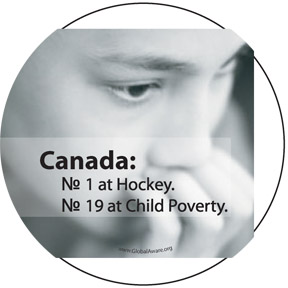Child poverty on the rise in B.C. but still no plan for relief
Could B.C. be the very last province to enact a plan to fight poverty?
That’s the question asked by B.C. Campaign 2000 last week as it published its latest report card on child poverty.
The province’s child poverty rate rose from 14.5 percent in 2008 to 16.4 percent in 2009, using Statistics Canada’s low income cut-offs before tax as a measure of poverty.
The after-tax rate rose from 10.4 percent in 2008 to 12 percent in 2009 – the highest of any province for the eighth consecutive year.
“Surely, it’s time for B.C. to follow the lead of seven other provinces and all three territories,” said Julie Norton, co-chairperson of First Call: B.C. Child and Youth Advocacy Coalition. “Reducing poverty is obviously good for people, and it also saves money for governments.”
British Columbia, Alberta and Saskatchewan are the only provinces without a formal poverty reduction strategy, but Alberta’s new premier Alison Redford says she favours a collective approach to preventing, reducing and eliminating poverty. That could leave B.C. and Saskatchewan as the only hold-outs. “What a shame it would be for B.C. to finish last,” Norton said. “We’ve noticed government has stopped making the claim that B.C. is the best place on earth. Is this a sign that they recognize that we have failed to fulfill one very basic function of government – meeting the needs of our poorest people?” B.C. Premier Christy Clark has made families the focus of her new government, but she and her ministers seem to believe that existing programs and policies somehow qualify collectively as an anti-poverty program. Meanwhile, the B.C. NDP has introduced a bill in the legislature to require a full-fledged poverty reduction plan with specific targets and timelines. “Surely B.C.’s high child poverty rate must be recognized as a problem that we all share. It is a problem that cuts across all levels of government and one we must all work together to solve,” said Lorraine Copas, Executive Director of Social Planning and Research Council of B.C. “The evidence tells us that living in poverty puts children’s health at risk and undermines their life chances. It’s costing us too much to allow the status quo to continue.” The before-tax statistics showed 137,000 poor children in B.C. in 2009 – up from 121,000 the previous year. Alarmingly, children under six had an even higher risk of living in poverty at 20.2 percent, or one in every five. The report card also showed:
- In 2009, nearly half of the poor children in B.C. lived in families with at least one adult working full-time, full-year, pointing to the problem of jobs that pay low wages.
- The poverty rate for children of lone-parent mothers fell to a record low 24.2 percent, thanks to more mothers with better jobs and fewer families on welfare. The poverty rate for children in two-parent families, however, rose to 15 percent.
- Most poor families with children live many thousands of dollars below the poverty line. Poor two-parent families had incomes $14,200 below the poverty line on average.
- Inequality remains a serious problem in B.C. and the rest of Canada. The poorest 50 percent of families with children in B.C. had less than one-quarter of all the personal income of families with children.
Campaign 2000 estimates that an investment of about $900 million is required to bring the incomes of poor families with children in B.C. up to the poverty line. The poverty gap – or the difference between the incomes of all poor people in B.C. and the poverty line – was $3.872 billion in 2009. The Report Card calls for reducing the child poverty rate to seven percent or less by 2020. Its specific recommendations include further increases in the minimum wage; increases in welfare rates and child tax benefits; enhanced Employment Insurance benefits and eligibility; universal access to high-quality, affordable child care; and improved access to post-secondary education. “Rising poverty rates for recent immigrants, particularly children and young adults is a serious concern,” said Timothy Welsh, Program Director for the Affiliation of Multicultural Societies and Service Agencies. “It makes no sense for governments to recruit immigrants, including highly-educated professionals, to join our labour force only to face immigration policies and employment practices which trap many of them and their children in poverty.” New recommendations for reducing the high poverty rates of recent immigrants include improving employment assistance, removing long-standing barriers to qualification for professionals trained abroad, making more language training available, and improving employment standards and the protection of human rights. B.C. Campaign 2000 is part of a national network that marks the anniversary every November of the 1989 pledge by the House of Commons to work to end child poverty by the year 2000. The 2011 Child Poverty Report Card was prepared by First Call: B.C. Child and Youth Advocacy Coalition and the Social Planning and Research Council of B.C. with the help of the Affiliation of Multicultural Societies and Service Agencies of BC.

























Comments